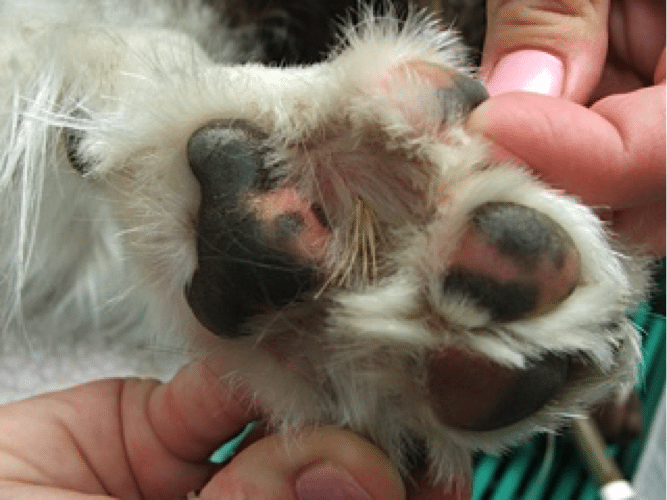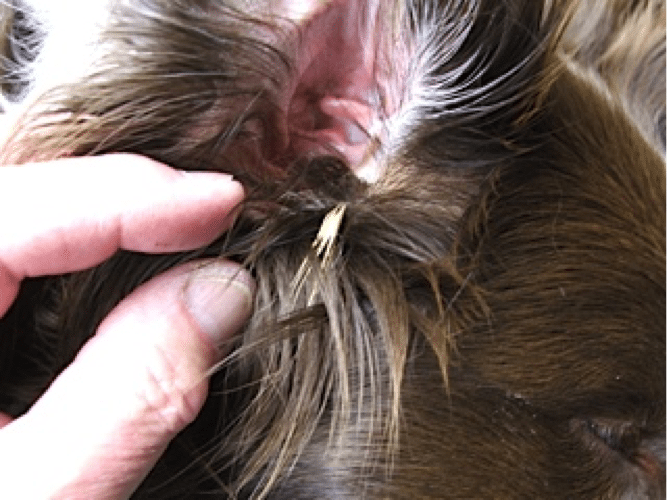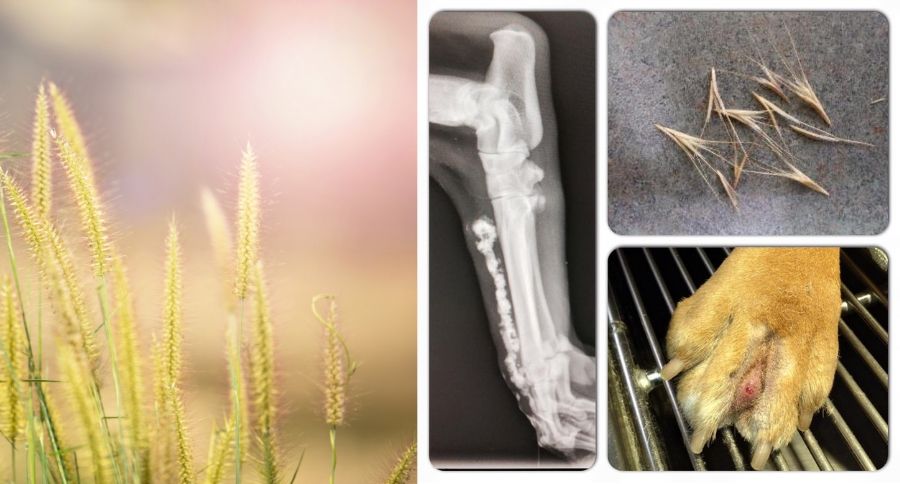Foxtail is a grass-like weed that makes its home in the Western half of the U.S.
Although the plant looks harmless enough, it can wreak havoc on your dog's insides. The barbed heads of the seed can burrow into your dog's insides from practically anywhere - skin, ears, eyes, nose, paws, genitals...you name it. The plant is often found in unkempt grassy areas, but can be found smack in the middle of cities, too.
What's more, the seeds are especially dangerous because they can be tough to spot and they don't break down inside the body. That means that an embedded foxtail left untreated can lead to infection, abscess, and even death for your dog.
A foxtail seed can potentially enter a dog's nose and eventually work its way into the brain. That's how persistent - and dangerous - these seeds are. Granted, that's a worst- case scenario, but it's important to realize that foxtails aren't something that should be ignored.
All dogs are vulnerable to foxtails, but long-eared, curly-haired dogs are more susceptible to embedded seeds.
So, how can you tell if your dog has an embedded foxtail? The following are some of the symptoms to watch for in and on different parts of the body:

A foxtail seed lodged in a dog's paw.
-Feet: Swelling of paws or limping can indicate an embedded seed. In addition, if your dog is licking a paw excessively, be sure to carefully examine the foot, including between the toes, for a hidden seed.

A dog's ears are easy ways in for a foxtail seed.
-Ears: Head shaking, head tilt and excessive ear scratching are all potential symptoms of an embedded seed. Even if you examine your dog's ear and can't find anything, it's possible for a seed to become embedded deep within the ear canal. You will need to take your dog to a vet in order for him or her to be examined using a special scope.
-Eyes: Swelling, discharge, redness, squinting, and pawing could indicate a foxtail in the eye. Consult a veterinarian immediately.
-Nose: Frequent and intense sneezing and nasal discharge are potential indicators of a foxtail lodged in the nasal passage. Seek veterinary care right away if you notice these symptoms.
-Genitals: Foxtails do not discriminate. They can lodge themselves literally anywhere, including the genitals. If you notice your dog licking the area excessively, the culprit could be a foxtail seed.

Now that you know what to look for, let's talk about prevention. Here are a few easy ways to spare your dog the trouble of foxtails:
-Carefully examine your dog's coat regularly.
This is especially important during foxtail season (May-December) and after you've been walking or hiking in open, grassy areas. Brush your dog regularly and keep a sharp eye out for the pointy foxtail awns in your dog's coat.
-Thoroughly inspect your dog's face and ears for foxtail seeds.
Don't forget to check inside the mouth and in the gums...no area is immune!
-Examine your dog's feet for any embedded seeds.
Check the paw pads and between all the toes.
READ MORE: How to Spot Tick Eggs
Use a pair of tweezers to pluck any foxtails you find and can access easily. However, if you discover a deeply embedded foxtail, or a foxtail surrounded by red or swollen tissue, consult your veterinarian immediately. Foxtails will not dislodge themselves on their own and MUST be removed.

Foxtails aren't exclusive to grassy fields. They can grow right in the middle of cities, too.
The most effective way to keep your dog safe from foxtails is to keep him or her out of unkempt grassy areas. Short of that, careful, regular full-body examinations are crucial. In addition, pull out any and all foxtail plants that might be growing on your property, and consider keeping your dog's coat trimmed during foxtail season.
Now that you're armed with the knowledge about what to look for and how to address any embedded foxtails you might find, get out there and have fun with your furry best friend!
Foxtail grass can be very scary for pet owners. These seed grass awns can travel through your dog's body or cause some terrible abscesses in your dog's skin. The easily get stuck in dog's fur, armpits, and paw pads.
Has your dog had foxtail woes? Tell us about it in the comments section below!
All in-body photos via Seattle DogSpot.




